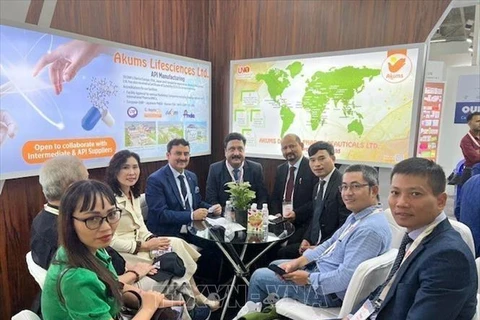 Sputnik V COVID-19 vaccine is made in Vietnan under the cooperation betweeb Vietnamese pharmaceutical company VABIOTECH and Russian Direct Investment Fund (RDIF). (Photo: baodautu.vn)
Sputnik V COVID-19 vaccine is made in Vietnan under the cooperation betweeb Vietnamese pharmaceutical company VABIOTECH and Russian Direct Investment Fund (RDIF). (Photo: baodautu.vn) Hanoi (VNA) – The lack of a breakthrough in vision and infeasible legal policies, worsened by complicated administrative procedures in pharmacy sector, are among limitations that make Vietnam less attractive to foreign investors, said Duong Thi Mai Hoa, managing partner at Hanoi-based Indusviet Legal LLC.
In her writing publicised on Dau tu ( Investment) newspaper on July 19, she said that since 2015, Vietnam’s pharmaceutical sector has recorded several significant achievements, thus taking its first step in attracting the attention of both prospective domestic and foreign investors as well as major pharma corporations to invest and collaborate with Vietnam.
The domestic pharmaceutical industry is prioritised for development, especially in areas of clinical pharmacy, manufacturing facilities, and related personnel via the promulgation of various policies.
For manufacturing facilities in particular, Vietnam’s pharmaceutical ecosystem is becoming more developed and very strongly linked with the increasing number of manufacturing factories, reaching the number of 250 factories and 200 exporting and/or importing facilities.
Nevertheless, there exist challenges for Vietnam to face, she said.
Over the past few years, especially during the COVID-19 pandemic, countries have paid more attention to health, medicine, and pharmacy with new approaches. As a result, the investment trend into pharmaceuticals in association with technology transfer is taking a clearer shape.
She said that Vietnam has made major strides in establishing policies and amending legislation in an attempt to provide guidance and reinforcement to the development of Vietnam’s pharmaceutical industry.
One of the prominent points is that the global trend of developing technology transfer in the industry is reflected in its contents. Subsequently, it sets out a specific target for technology transfer by 2030 to transfer production technology of at least 100 innovator drugs with valid trademarks, vaccines, medical biologicals, and medicine which Vietnam has not been able to produce.
In practice, investment in pharmaceuticals is also starting to see a transition. At the beginning of 2022, Indian enterprises entered into an MoU on funding Vietnam-India Pharmaceutical Park with Dai An Urban-Industrial Zone Development Corporation in the northern province of Hai Duong.
With a total capital reaching 10-12 billion USD, this project is expected to be a strategic lever to propel Vietnam to become a leading pharmaceutical research, development, and manufacturing institute in Southeast Asia.
Apart from Indian enterprises, a plethora of multinational corporations such as Sanofi and Nipro Pharma are expected to continue pouring money and increasing their presence in Vietnam.
Despite a transition in the legal policies of Vietnam in providing more incentives for better attraction of foreign capital, such policies, nonetheless, prove insufficient in the long run for investors to cope with the complicated or unspecified legal procedures in Vietnam as well as the humbleness of objective aspects on manufacturing facilities, materials, personnel, and policies on domestic drug prices.
Desite the Law on Technology Transfer started taking effects in July 2018, there is yet to exist any provision expressively stipulating the procedures and process of pharma tech transfer in Vietnam.
The Ministry of Health has drafted a circular guiding the activity of drug processing and technology transfer in drug manufacturing as a replacement to a 2013 circular guiding the activity of drug processing. But currently, this circular is yet to be approved, thus effectively leaving a gap in the legal framework./.
























